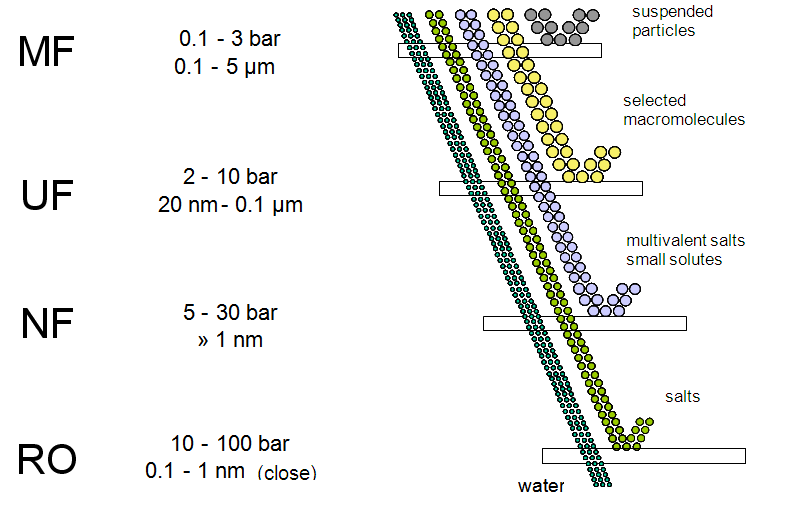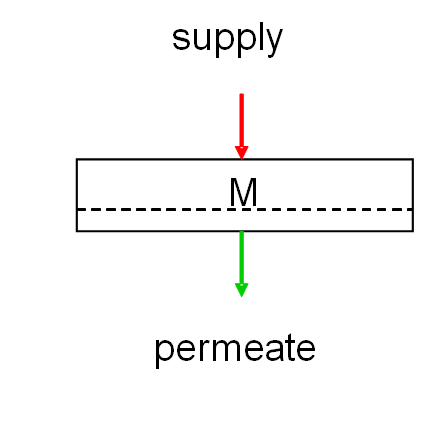Method diagram

Method and installation description
Micro-filtration (or MF for short) is one of the pressure-driven membrane processes in the series micro-filtration, ultra-filtration (UF), nano-filtration (NF) and reverse osmosis (RO). The micro-filtration process uses a membrane – a simple permeable material – which, in the case of micro-filtration, only allows particles smaller than 0.1 microns to pass through it. The micro-filtration membrane can consist of various materials like, for example, polysulfone, polyvinyldifluoride (PVDF), polyethersulfone (PES), ZrO2 and carbon. The pore size varies between 0.1 and 5 microns. Because the pores are large compared to other mentioned filtration techniques, pressure – needed to send the liquid through a micro-filter membrane – is limited to 0.1 to 3 bar.
Micro-filter membranes are offered in various configurations by suppliers, with each configuration having a specific use and accompanying advantages and disadvantages. Possible membrane configurations include:
- Pipe-shaped membranes: capillary, hollow fibre or tubular;
- Plate-shaped membranes: flat plate or spiral
In addition to the specific membrane configurations, one can also identify a few set-ups. The 2 most commonly used methods are dead-end and cross-flow set-ups. The names refer to the way in which the supply is sent to the membrane. In dead-end MF, the supply is sent directly to the membrane. The pollution layer will thus form on the supply side of the membrane surface. This layer contains all particles that have been separated on the basis of their size (sieve effect). This layer is periodically rinsed away by briefly re-sending the produced liquid (permeate) through the membrane in an opposite direction to the production flow. This helps to loosen the hardened layer, and makes it ready for disposal. This is referred to as a semi dead-end set-up.
This re-rinsing may not be enough to remove the layer from the surface if the hardened layer is too strongly compressed or if the bond with the membrane is very strong. In this case, chemical cleaning must be implemented with, for example, bleach, peroxide, acid and alkali or detergent.
The figure below shows a dead-end set-up, where M = the membrane.

In a cross-flow set-up (see figure below), the liquid is passed along the membrane surface at a particular speed. The permeate is able to pass through the membrane and the larger particles are left behind in a concentrated flow (the retentate). The hardened layer in this set-up is continuously removed by the cross-flowing supply flow.

Specific advantages and disadvantages
The advantages of MF are:
- Low operating pressure required;
- Low energy consumption for semi dead-end set-up, compared to nano-filtration or reverse osmosis;
- Few manual actions required;
- Relatively cheap;
- No energy-consuming phase transfer needed, such as e.g. evaporation techniques;
- Quality of the produced permeate is not determined by the management.
Possible disadvantages of MF are:
- Only suspended matter and bacteria removed ((~log 5 removal);
- Sensitive to oxidative chemicals (e.g. nitric acid, sulphuric acid, peroxide and persulphate in high concentrations);
- Damage can be caused by hard and sharp particles > 0.1 mm, whereby pre-filtration is necessary;
- Membrane damage if re-rinsed at pressure in excess of 1 bar.
Application
Micro-filtration is primarily used as a pre-treatment step in the production of drinking and process water. It has excellent properties for removing suspended matter, bacteria and cysts. It is an alternative to classic sand filtration. Further, cross-flow MF is used in the:
- Dairy industry (cheese, milk,…);
- Food industry (clarification of fruit juice, wine, beer, etc.);
- Metal industry (oil/water emulsion separation);
- Textile industry (effluent treatment);
- Pharmaceutical industry (cold sterilisation).
MF is also implemented for the re-use of wastewater. In this case, it can be combined with a biological step in a membrane bioreactor.
Boundary conditions
Membranes must be protected against hard particles larger than 0.1 mm. They can be removed by regular pre-filtration. Further, supply flows and pH conditions must be compatible with the membrane material.
Effectiveness
MF can be implemented for removing the following parameters:
- Suspended matter (>99%);
- Harmful micro-organisms (e.g. bacteria, protozoa, algae, fungi) (>99%).
- PAHs.
Further, MF can also be implemented to break down emulsions.
Support aids
Support aids like bleach, peroxide, acid, alkali or detergent can be used to chemically clean the MF installation.
Environmental issues
The concentrate from an MF has a high concentration of suspended matter and bacteria. This can be discharged together with wastewater if discharge norms are not breached. Rinse waters after chemical cleaning contain substances like bleach and formed AOX, peroxide, acid and alkali. These rinse waters can only be discharged to specific waste purification systems.
Costs
Typical installation costs for micro-filtration (tubular membranes, PVDF) with a volume of 25 m³/day, amount to between € 25.000 and 50.000 depending on the quality of the water supply. Difficult to treat supply water is more expensive to process due to the choice of membrane material, total membrane surface area and the special cleaning techniques needed for the membrane. For MF, one should assume an average operating costs of 0.1 to 0.15 €/m³ produced permeate.
Comments
/
Complexity
/
Level of automation
/
References
- Bonnélye V., Guey L., Del Castillo J., Desalination, Volume 222, Issues 1-3, 1 March 2008, Pages 59-65, 2008
- EIPPCB, Reference Document on BAT in Common Waste Water and Waste Gas Treatment / Management Systems in the Chemical Sector, draft February 2009 (revision upon release)
- Mulder M., Basic Principles of Membrane Technology, Kluwer Academic Publishers, Dordrecht (NL), 1996.
- Dutch Membrane Guide, version 2.0, 1996
- TNAV, supplier survey, 2008
- VITO-SCT, revision of technical notes WASS, 2008
Version February 2010

